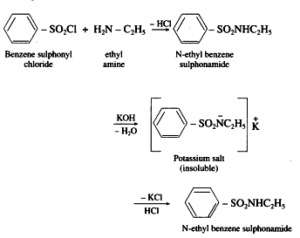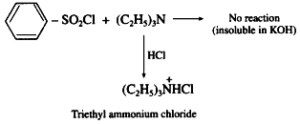chapter 13 Amines Class 12 Chemistry Textbook Solution
4. Answer the following.
vii. Distinguish between ethylamine, diethylamine and triethylamine by using Hinsberg’s reagent ?
Answer:-
(i) When a primary amine, such as ethylamine, undergoes a reaction with Hinsberg’s reagent (benzenesulfonyl chloride), it forms N-alkyl benzenesulfonamide. This compound is soluble in an aqueous solution of potassium hydroxide (KOH), resulting in the formation of a clear solution of potassium salt. Upon subsequent acidification, the N-alkyl benzenesulfonamide becomes insoluble.

(ii) In the case of a secondary amine, like diethylamine, reaction with benzenesulfonyl chloride results in the formation of N,N-diethyl benzenesulfonylamide. This compound remains insoluble when placed in an aqueous KOH solution and does not dissolve when subjected to an acid environment.

(iii) Tertiary amines, such as triethylamine, do not react with benzenesulfonyl chloride and thus remain insoluble in KOH. However, they can dissolve in dilute hydrochloric acid (HCl) to produce a clear solution due to the formation of an ammonium salt.

13 Amines Class 12 Chemistry Textbook Solution page 297
Question bank with Solution
Text book Solution
NCERT Solutions
NCERT Solutions for Class 12 Maths
NCERT Solutions for Class 12 Physics
NCERT Solutions for Class 12 Chemistry
NCERT Solutions for Class 12 Biology
NCERT Solutions for Class 11 Maths
NCERT Solutions for Class 11 Physics
NCERT Solutions for Class 11 Chemistry
NCERT Solutions for Class 11 Biology
NCERT Solutions for Class 10 Maths
NCERT Solutions for Class 10 Science
Board/University Study Material
Question Paper Solutions
CBSE Previous Year Question Paper With Solution for Class 12 Arts
CBSE Previous Year Question Paper With Solution for Class 12 Commerce
CBSE Previous Year Question Paper With Solution for Class 12 Science
CBSE Previous Year Question Paper With Solution for Class 10
Maharashtra State Board Previous Year Question Paper With Solution for Class 12 Arts
Maharashtra State Board Previous Year Question Paper With Solution for Class 12 Commerce
Maharashtra State Board Previous Year Question Paper With Solution for Class 12 Science
Maharashtra State Board Previous Year Questio n Paper With Solution for Class 10
CISCE ICSE / ISC Board Previous Year Question Paper With Solution for Class 12 Arts
CISCE ICSE / ISC Board Previous Year Question Paper With Solution for Class 12 Commerce
CISCE ICSE / ISC Board Previous Year Question Paper With Solution for Class 12 Science
CISCE ICSE / ISC Board Previous Year Question Paper With Solution for Class 10
